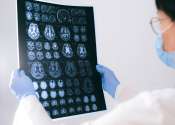Charcot–Marie–Tooth disease- (CMT), known also as Morbus Charcot-Marie-Tooth, Charcot-Marie-Tooth neuropathy, hereditary motor and sensory neuropathy (HMSN), hereditary sensorimotor neuropathy (HSMN), or peroneal muscular atrophy, is an inherited disorder of nerves (neuropathy) that takes different forms. It is predominantly characterized by loss of muscle tissue and touch sensation, in the feet, ankles and legs as it progresses over time, but also in the hands, wrists and arms in various types of the disease. Early and late onset forms occur with 'on and off' painful spasmodic muscular contractions that can be disabling when the disease activates. High arched 'Cavus Feet' are associated with the disorder. Sensory and positioning nerves in the hands and feet are often damaged, while pain nerves are left intact. Overuse of an affected hand or limb can activate symptoms ranging from numbness, to spasm, to very painful cramping. Currently incurable, this disease is one of the most common inherited neurological disorders, and was considered a type of Muscular Dystrophy for years.
Estimates of incidence vary widely from 1 in 380,000 people affected to 1 in 2,500 people affected [1]. This larger figure might equate to approximately 23,000 people in the UK and 125,000 people in the USA.









